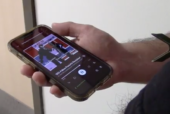Non-fungible tokens — or NFTs — are changing the digital world as we know it.
In total, collectors have spent billions of dollars to own JPEG image files — images that could depict anything from a baseball card to a concert ticket to even a mural or portrait. On the NFT market, some of these files hold as much value as some of the world’s most famous art pieces.
Interest in these images is growing. In 2020, Dapp Radar says NFT sales totaled less than $100 million. Last year, sales skyrocketed to more than $24 billion.
In Dec. 2021, sold for over $90 million, with about 30,000 people pooled together more than $90 million to purchase an NFT piece called “The Merge.” Each contributor now owns a small piece of the NFT..
There are still so many unanswered questions about NFTs: Could NFTs be used for money laundering? Who could prevent someone from copying an NFT and claiming it as their own? Are NFTs just another means for the rich to get richer?
To Adrian Swish, an NFT advisor and CEO of his own digital music company Digital Currensy, the biggest issue is the lack of regulation. Swish said there are methods for tracking NFT transactions publicly — but it’s not clear who is responsible for overseeing this new market, and how much oversight there should be.
“It’s the wild wild west,” Swish said. “We’re still trying to figure it out.”
“There’s too many people losing money — too many frauds and scams, that can turn people away from getting in” to the NFT market, said Jon Healey, senior editor for utility journalism at the L.A. Times.
According to Expensivity, anyone hoping to purchase NFTs must pay using cryptocurrency, specifically Ethereum; NFT sellers don’t accept traditional currency.
Swish says many NFT sales are not only about making money but can help bring awareness to an issue or help charitable causes. An NFT project made by Mike Winklemann, who goes by Beeple, sold for $6 million dollars and the proceeds went to the Open Earth Foundation to fight climate change. Other NFT projects like the Dainty Dolphins were created to bring awareness of the endangered species, as well as other projects that are similar.
Swish urges anyone interested in getting into NFTs, that it can be used for things much bigger than making money.
“Educate yourself,” Swish said, “and then figure out how you can maximize it, understanding the technology… think bigger than trying to make money, make an impact.”
The reach of NFTs isn’t just art, it can range from sports trading cards, moments in time captured in small clips to even a ticket to the movies, concerts, etc.
This year the Super Bowl released commemorative NFT tickets from NFL and Ticketmaster. Although these tickets couldn’t get you in the game, you can resell for hundreds or even thousands more than what you bought it for.
What does the future of NFTs look like?
Los Angeles Times Editor Jon Healey thinks something will have to be done about possible fraud. Beyond that, he said, “there’s a lot of imagination still to be applied and that’s when it’s going to get interesting.”
“I see it as the Industrial Revolution,” Swish said. “You have a new set of technology and everyone is racing to redefine their industry.”
This story was produced by Sofie Bredahl, David Reyes and Daniel Sandoval.

 Tweet this Video
Tweet this Video Share on Facebook
Share on Facebook Share via E-mail
Share via E-mail

